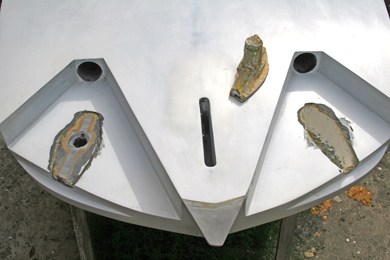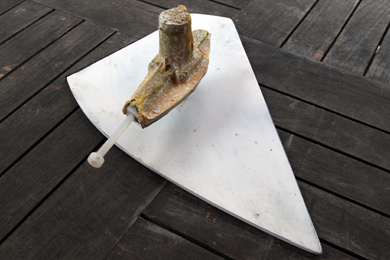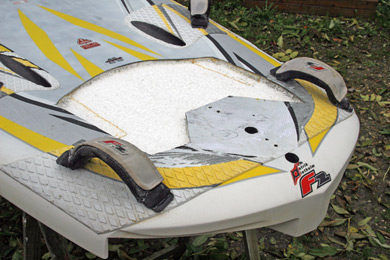| F2 FX 100 IV | |
|
F2 FX 100 IV is pretty close to the F2 III in design, but to overcome the problems with "lift-offs" (probably fortified by a a shorter rocker straight in the tail) the board has a couple of plates in the cut outs, so that in fact you can adjust the depth of the cut outs. The point is, that you can leave the plates on shore (or adjust them high in the cut outs) in light winds, so that the board sail more free. And in increasing winds you can lower the plates to get more dynamic lift in the tail, helping the board not to lift its nose.
Now, do the plates help in the intended way? Well, I haven't been able to feel any difference. Probable because of a pretty early starting scoop (which means a short straight in the tail) the F2 IV (almost as the F2 III) isn't as easy to control as the Starboard 160 (or 159) - and IMHO this feeling doesn't change at all by lowering the plates. If you wish delay the time for the nose lifting, it shall probably be more efficient to install a flap behind the fin box - but of course this can't be removed or put in place on demand. By the way - many F2 IV sailors place the boom rather low to get more pressure on the forward foot, in this way hoping to avoid an early launch from the sea.
There seem to a large variety in the attitudes to the adjustable cut outs - but generally the F2 team sailors give the plates great credit, while a lot of F2 IV sailors without economical ties to F2 consider the plates to be a gimmick without noticeable effect. And lucky so - as a lot of plates break loose and disappear during sailing without you're able to feel any change in lift or (extra) lack of control). In face confidential, to face talks with the team sailors, you can might get the impression that the pilots in the international scene don't bother about the plates either - yes, some competitors are even said to have sailed several races without noticing that only one plate was in place.
The F2 IVs we have had in this place have been clearly heavier than both the F2 III and Starboard 158, 159 and 160 (about 1 kg heavier). When you balance the board, it's obvious that the extra weight is placed in the tail - and it's pretty logical to suspect the plates, tubes, pins, the hidden nylon devices and the extra bends and curves in the tail deriving from this to be guilty. Putting on the scales the plates with tubes and split pins (2 x 185 grams) and nylon devices (2 x 75 grams) equals some 0.5 kg, and I wonder if not the extra packing in weave and epoxy and the extra bends and curves amount to another couple of hundreds of grams? What the "air pipes" weigh extra relative to Starboard, I don't know - but anyway, it must be allowed to conclude that if you consider the adjustable plates (and the air pipes) for being gimmicks, then there's a price to pay in terms of weight.
For us mortals the F2IV - as a result of the rather short rocker straight and the extra weight in the tail - is slower to plane than both the contemporary Starboards and the F2 III. In transition between slogging and planing it feels like there is a very delicate balance: On one hand not to put pressure too far forward, so that the banana curve under the mast track and forward ploughs through the water - and on the other hand not to place the weight too much on the tail, so that the deep cut outs and the rather narrow tail are dug in the water. But otherwise the F2 IV (like the F2 III) is a very fast board downwind, where you can go fantastic deep without fearing to stick in the back of a wave or chop. Generally, the F2 IV is probably a little more technical to sail well than the contemporary Starboard 160.
The contour of the deck is almost the same as on the F2 III - and it's just as prone to take form from rigs, lying out over the rail, heavy foot work and the like. and furthermore at least one board at this place has been so week built between the foot straps that a large area has been rebuilt because of delaminating sandwich material and water consumption (see below). If this has been an individual defect I don't know ... |
|
| Video sequences with a F2 IV (and a F2 III) in action. | |
 |
The plates covering the cut outs have been removed, and the nylon devices holding the plates have been exposed.
The reason for this little operation was partly that the sandwich material covering the nylon devices was cracking - and partly curiosity. |
 |
This is one set of plate,
split pin and nylon device, holding the plate. You can't see the tube
entering the device from the plate. Weight for one set: Almost 300 grams. |
 |
A delaminated F2 FX 100 IV has got the sick sandwich material removed. In fact the board was rather soft up between the intake for the air pipes too, but at one place you've got to stop. |